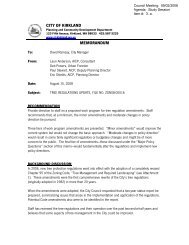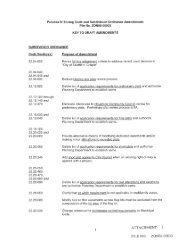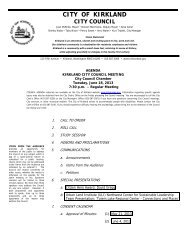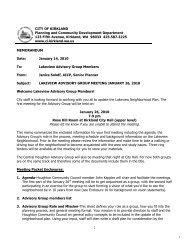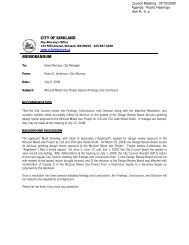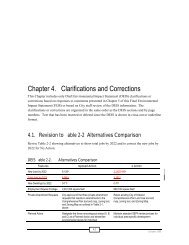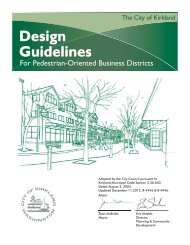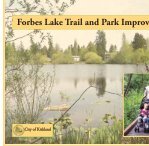Low Impact Development (LID) Feasibility Study - City of Kirkland
Low Impact Development (LID) Feasibility Study - City of Kirkland
Low Impact Development (LID) Feasibility Study - City of Kirkland
You also want an ePaper? Increase the reach of your titles
YUMPU automatically turns print PDFs into web optimized ePapers that Google loves.
<strong>Kirkland</strong> <strong>LID</strong> <strong>Feasibility</strong> <strong>Study</strong> for CIP Projects MatrixAs part <strong>of</strong> the evaluation process, a matrix comparing <strong>LID</strong> benefits and opportunities was created to summarize eachproject. This matrix is meant to be used as a tool for <strong>Kirkland</strong> to compare the various projects considering not only thestormwater benefits but additional benefits associated that can result from incorporating <strong>LID</strong> elements into the right<strong>of</strong>-way.The following matrix is broken into six sections:•CIP Info – This section lists the general CIP project information including what the drainage basin where the projectis located.•<strong>LID</strong> Approach – This column lists the proposed <strong>LID</strong> elements.••••<strong>Low</strong> <strong>Impact</strong> <strong>Development</strong> (<strong>LID</strong>) Criteria – Stormwater function, demonstration potential, capital cost, and baselinemaintenance efforts were scored high (value <strong>of</strong> 3), moderate (value <strong>of</strong> 2), or low (value <strong>of</strong> 1). This rating system wasused to quantify the incorporation <strong>of</strong> <strong>LID</strong>. The range for the cumulative scoring in the last column is as follows: High12-11, Moderate 10-8, and <strong>Low</strong> 7-4.Other Benefits from Proposed <strong>LID</strong> Elements – Additional benefits <strong>of</strong> <strong>LID</strong> elements include ecological function,habitat and human health, and ecological connectivity. In addition, the projects were evaluated for how theyaligned with the <strong>Kirkland</strong> Comprehensive Plan Framework Goals and encourage interagency collaboration.Finally, the proposed elements were evaluated for the promotion <strong>of</strong> carbon neutral patterns including increase <strong>of</strong>pedestrian and bicycle facilities as opposed to increased street width for vehicular traffic. These benefits were alsoscored as either high (value <strong>of</strong> 3), moderate (value <strong>of</strong> 2), or low (value <strong>of</strong> 1). The range for the cumulative scoring inthe last column is as follows: High 21-18, Moderate 17-14, and <strong>Low</strong> 13-7.Cumulative Priority Valuation – This column totals the cumulative valuation score for the Cumulative <strong>LID</strong> ValuationScore and the Cumulative Benefit Valuation Score. The range for the scoring is as follows: High 33-28, Moderate 27-21, and <strong>Low</strong> 20-11Collaboration Opportunities – These columns indicate the potential for <strong>Kirkland</strong> to engage the community, otheragencies, and organizations through the design and even the maintenance <strong>of</strong> the proposed <strong>LID</strong> elements.The results <strong>of</strong> the evaluation matrix should be used in conjunction with the following conceptual cross sectionsand images <strong>of</strong> how <strong>LID</strong> elements could be incorporated within the right-<strong>of</strong>-way. In addition, a map indicating thegeographical context <strong>of</strong> the project and where it is in relation to nearby waterbodies, schools, and parks.c<strong>City</strong> <strong>of</strong> <strong>Kirkland</strong> <strong>LID</strong> <strong>Feasibility</strong> <strong>Study</strong> for CIP Projects | SvR No. 07016 | December 21, 2007




